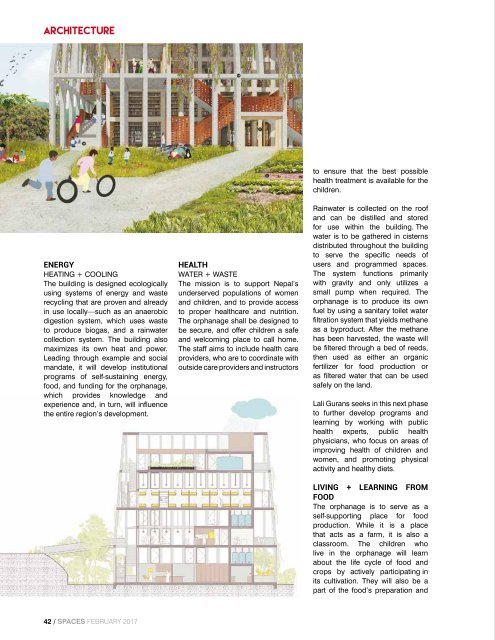SPACES feb issue 2017
You also want an ePaper? Increase the reach of your titles
YUMPU automatically turns print PDFs into web optimized ePapers that Google loves.
Architecture<br />
Energy<br />
Heating + Cooling<br />
The building is designed ecologically<br />
using systems of energy and waste<br />
recycling that are provenand already<br />
in use locally—such as an anaerobic<br />
digestion system, which uses waste<br />
to produce biogas, and a rainwater<br />
collection system. The building also<br />
maximizes its own heat and power.<br />
Leading through example and social<br />
mandate, it will develop institutional<br />
programs of self-sustaining energy,<br />
food, and funding for the orphanage,<br />
which provides knowledge and<br />
experience and, in turn, will influence<br />
the entire region’s development.<br />
Health<br />
Water + Waste<br />
The mission is to support Nepal’s<br />
underserved populations of women<br />
and children, and to provide access<br />
to proper healthcare and nutrition.<br />
The orphanage shall be designed to<br />
be secure, and offer children a safe<br />
and welcoming place to call home.<br />
The staff aims to include health care<br />
providers, who are to coordinate with<br />
outside care providers and instructors<br />
to ensure that the best possible<br />
health treatment is available for the<br />
children.<br />
Rainwater is collected on the roof<br />
and can be distilled and stored<br />
for use within the building.The<br />
water is to be gathered in cisterns<br />
distributed throughout the building<br />
to serve the specific needs of<br />
users and programmed spaces.<br />
The system functions primarily<br />
with gravity and only utilizes a<br />
small pump when required. The<br />
orphanage is to produce its own<br />
fuel by using a sanitary toilet water<br />
filtration system that yields methane<br />
as a byproduct. After the methane<br />
has been harvested, the waste will<br />
be filtered through a bed of reeds,<br />
then used as either an organic<br />
fertilizer for food production or<br />
as filtered water that can be used<br />
safely on the land.<br />
Lali Gurans seeks in this next phase<br />
to further develop programs and<br />
learning by working with public<br />
health experts, public health<br />
physicians, who focus on areas of<br />
improving health of children and<br />
women, and promoting physical<br />
activity and healthy diets.<br />
Living + Learning from<br />
Food<br />
The orphanage is to serve as a<br />
self-supporting place for food<br />
production. While it is a place<br />
that acts as a farm, it is also a<br />
classroom. The children who<br />
live in the orphanage will learn<br />
about the life cycle of food and<br />
crops by actively participatingin<br />
its cultivation. They will also be a<br />
part of the food’s preparation and<br />
42 / <strong>SPACES</strong> February <strong>2017</strong>


















